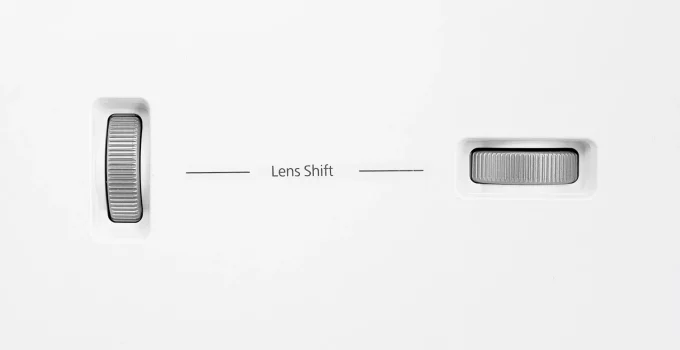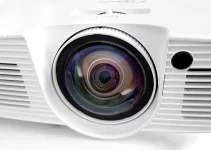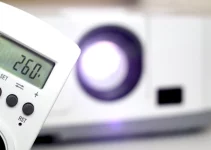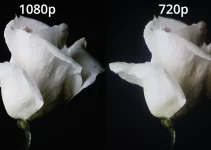While coming across projectors with only vertical lens shift or only keystone correction is almost as easy as looking up at the sky, looking for the best projectors with horizontal lens shift takes a bit more time and a bit more research.
If you want a surefire way of making sure that you only come across projectors with both vertical and horizontal lens shift, then you must look for projectors from Epson. Most of their models, especially those with prices higher than $1000, will include both and that’s one of the reasons I love this brand so much.
I own both a lens shift projector and an Optoma one that only has vertical. While I love the image quality from Optoma, it was a bit weird adjusting to only having vertical lens shift but it’s certainly doable. I don’t see the vertical-only feature as a con.
Still, we’re here to look for projectors with horizontal lens shift besides the more easily encountered vertical and that’s what we’re going to do.
If you can stick only with vertical, you’ll have your choice of manufacturers to choose from: Optoma, Viewsonic, BenQ, LG.
On the other hand, if we absolutely want a horizontal lens shift, our choices are absolutely limited.
And that’s why you’re going to see a few Epson models today. Well, even I reviewed the best ceiling mounted projectors I recommended quite a few Epson models so it’s not like this is something new with me.
Table of Contents
Best Projectors With Horizontal Lens Shift
Since horizontal lens shift projectors are harder to find and I already mentioned that Epson projectors are most of the time a sure thing, am I only going to review Epson models as the best projectors with horizontal lens shift?
Well, that wouldn’t be so bad because this manufacturer makes some awesome models. Plus, I love that we can cover a whole array of price ranges if we look for some of the most awesome projectors from Epson.
While they sell models that cost $3,000-$5,000, we can also find projectors that will cost around $1,000. So, if we’re going for Epson, there’s a high chance that we’ll find a model that will match our budget.
However, while Epson is indeed a great brand, it wouldn’t be fair to only focus on their lens shift projectors.
So, we’ll also include models like the Yaber Y30 for those who are looking for a projector under $300. However, we get no lens shift with this one. The horizontal & vertical are digital keystone corrections. If you have a lower budget, that’s the compromise you’ll have to make.
On the other hand, the LG CineBeam HU710PW is a model with both vertical and horizontal lens shift that might interest people with a budget around $2,000 and no desire to own an Epson. This LG is a pretty fantastic device.
Last but not least, we have the ViewSonic LS900WU, a data lens shift projector that can be a good match for big venues.
Also, if you want, check out my reviews for the best ALR projector screens.
1. Epson Home Cinema 5050UB: One of the Best Projectors with Horizontal Lens Shift
If there is one expensive projector that I love to recommend, that’s the Epson Home Cinema 5050UB.
Simply put, the image quality is one of the best I’ve ever come across. Even if I compare it with the more expensive Epson Home Cinema LS11000, I just think that the Home Cinema 5050UB wins. The overall image quality is just better but the LS11000 also has some additional impressive specs.
However, the difference between the two is that the 5050UB is a lamp-based projector, while the LS11000 is a laser projector. That’s the huge difference between them and we could say that that price difference is quantifiable in the form of about $1,000.
Lens shift
Of course, in this price range, around $3,000, we can expect both horizontal and vertical lens shift.
The lens shift is impressive: +/- 96% V and +/- 47% H and 10 memory presets.
It truly is one of the best horizontal lens shift projectors.
Resolution
The 4K PRO-UHD native resolution is absolutely the most impressive spec about the Epson Home Cinema 5050UB.
It’s not true 4K but it’s pretty close so I’m not going to say that there’s a huge difference between the two.
4K PRO-UHD translates into 3840 x 2160 pixels.
True 4K is 4096 x 2160 pixels.
The color modes for 2D are: Dynamic, Bright Cinema, Natural, Cinema, Digital Cinema, Black & White Cinema.
A contrast ratio of 1,000,000:1 is really incredible.
The throw ratio is 1.35-2.84. It’s a long throw.
3D projector
Indeed, it’s a 3D projector. You’ll have to buy glasses for it though.
The color modes for 3D are: Dynamic, Cinema.
Brightness
We get a 2,600 ANSI lumens brightness. It’s not incredibly high but this is a home theater projector that is best enjoyed in the dark.
Lamp life
The lamp life is up to 3,500 hours on High and up to 5,000 hours on Eco.
It’s not exactly the highest lifespan we could get but it will still last a good number of years until we need to get a new lamp.
Of course, for those who don’t want to spend around $3,000 on a lamp-based device, the Home Cinema 5050UB won’t sound all that awesome.
Personally, I have no problem with knowing that I will have to buy a new lamp a few years down the line. I’m totally used to it by now since I have gone through a few lamps with my projectors.
Connections
We only get the absolute basics: 2 HDMI, 2 USB, mini USB, LAN.
Well, I love the 2 HDMI ports so you’ll hear no complaints from me. One is for 3D content.
You’ll notice that the Audio port is not included.
No Bluetooth support. Our speakers will either have to be connected via HDMI or we can connect them to the source device (phones, laptops, tablets, etc.).
There are no built-in speakers.
It’s also a big model that weighs 24.7 pounds. The power consumption is 283 W – 373 W.
2. Epson Home Cinema 3200: Best Value for Money
While I truly love the Home Cinema 5050UB, I can totally understand that it’s not for everyone.
On the other hand, given that the Epson Home Cinema 3200 can be almost 2.5 times cheaper, it might appeal to a lot more users.
Lens shift
The lens shift is pretty awesome. We don’t get the biggest numbers but it’s still more than enough.
+/- 60% vertical lens shift.
+/- 24% horizontal lens shift.
Resolution
Given that it has a price only a bit above $1,000, Full HD 1080p native resolution might be what you expect.
However, I love that the Home Cinema 3200 actually offers us 4K Pro-UHD native resolution.
That’s totally amazing and impressive and I just love it.
What is to be expected is that the image quality is totally fantastic, no doubt about it.
It’s a 4K 3849 X 2160 pixels resolution.
We also get up to 40,000:1 contrast ratio. It’s not very high but it’s pretty good.
The throw ratio is 1.32 – 2.15.
Plus, it’s a 3D projector.
Brightness
The 2,900 brightness is pretty spectacular. It can work in ambient light but it would be even better in a dark environment.
Lamp life
Lamp life is pretty low, among the lowest we’ll come across of up to 3,500 hours.
That means that we’ll have to change the lamp sooner, especially if we use our device for many hours each day. That still will amount to a few good years of use so it’s not all bad.
Connections
We get everything we need: 2 HDMI, USB A, Audio out.
One of the HDMIs is for 3D content.
And we get Bluetooth support, which is pretty unusual for Epson. It means that we can connect Bluetooth speakers.
It weighs 14.6 pounds.
3. LG CineBeam HU710PW
This can be a nice pick for people with a budget around $2,000.
While the LG CineBeam HU710PW is not as popular as many other Epson projectors, I still believe that it can be one of the best projectors with lens shift for people with a pretty generous budget.
Lens shift
We get a pretty nice lens shift:
+/- 60% vertical
+/- 24% horizontal
Resolution
The 4K UHD (3840 x 2160 pixels) resolution is one of the best features about the LG CineBeam HU710PW.
There’s also a 2,000,000:1 contrast ratio.
Brightness
The 2,000 ANSI lumens is pretty much the only spec that is not absolutely spectacular.
If you’re buying the LG CineBeam HU710PW for a dark room only, that won’t be a problem.
LED-laser hybrid
The CineBeam HU710PW is an interesting combination that works with a laser-LED hybrid light source. It’s certainly an interesting combination and not something that we come across often.
Well, with the laser-LED combination we get up to 20,000 hours at full brightness and up to 30,000 hours lifespan.
Connections
We get all the necessary ports, which amount to 3 HDMI ports. There’s no Audio out.
As with all the other LG projectors, the CineBeam HU710PW also includes the LG SMART TV.
It means that we don’t need a streaming device to access whatever apps and streaming services we need. We already have an OS with a web browser and we can download Netflix and whatever else we want.
Plus, with the LG CineBeam HU710PW, we come across another horizontal lens shift projector that has Bluetooth support.
It also has 2 10W integrated built-in speakers. It might be enough for some viewers so you might not feel the need for external speaker(s).
4. ViewSonic LS900WU
It might seem strange that one of the most expensive horizontal lens shift projectors from my reviews is this ViewSonic LS900WU. I mean, some of you might say that I should have reviewed a Sony projector since we’re almost in the $3,0000-$5,000 price range.
Sony is great for home theaters. But ViewSonic is great for businesses, education uses, and house of worship uses.
I will admit that I’m intrigued about this ViewSonic as a data projector with lens shift.
I also reviewed a ViewSonic device as one of the best projectors for daylight but that was a cheap model with only vertical lens shift.
Lens shift
The lens shift is not very generous but it’s there: +/- 2.5% H and -2.4% +9.2% V.
Resolution
The WUXGA resolution (1920 x 1200) is not something you might expect from a lens shift projector but this is a data projector that can also be used at home for watching movies and whatever other content we want.
The 16:10 aspect ratio is expected. We can also select a 4:3 or 16:9 aspect ratio.
While the ViewSonic LS900WU can be used as a home theater projector, I actually recommend Epson devices if that’s what you’re looking for.
Instead, this ViewSonic is just a wonderful horizontal lens shift projector for large venues, for business or for education purposes.
It is perfect for auditoriums, lecture halls, large boardrooms, houses of worship, and more. That’s what the ViewSonic LS900WU was created for.
The throw ratio is 1.2 – 1.9.
Brightness
If there is one thing I expect almost always from ViewSonic that is bright images in any environment. The ViewSonic LS900WU isn’t any different.
The 6,000 ANSI lumens brightness is mind-blowing. You can be sure that it handles any light settings. That’s the main selling point here.
It is bright and versatile for any professional installation. It delivers everything we need for big projection screens in big venues.
This manufacturer excels at making impressive data projectors that can be used in business/education settings just as well as they can be used in home theaters.
Lamp life
It’s a laser lens shift projector that doesn’t need any lamps changed in the future.
The lifespan is estimated at 20,000 hours on Normal and 30,000 hours on Eco.
It includes a long-lasting Laser Phosphor Light Source.
Plus, it’s a DLP.
Connections
The ports we get are: 3 HDMI ports, USB A, VGA, mini USB, Audio out.
5. Epson Home Cinema 880
We saw what some of the best devices offer when they have a price above $1,000. The Epson Home Cinema 3200 doesn’t exceed the $1,000 limit by much so it’s the best pick for people on a budget.
However, how about people whose budget is in the $600-$700 range?
In that case, we won’t be able to get a device with horizontal & vertical lens shift.
We only get keystone correction. It’s not ideal but I’m sure that we can make it work.
I will admit that the Epson Home Cinema 880 is one of my favorites, whether we’re looking for the best projectors for the bedroom or the best projectors for watching sports.
In short, the Home Cinema 880 is a model that can suit a lot of people, a lot of situations, different needs, and one that can be quite affordable for most of us. And that’s why it also was one of my favorites as a projector for dorm rooms.
It’s highly versatile and I love it.
I’m not going to say that it’s the best of the best and it will suit everyone. But it can be a good device for people who want quality for a price well under $1,000. That’s what makes it so wonderful.
Of course, if your expectations are in the $2,000-$5,000 price range, we got a few of those reviewed in this article.
Lens shift
We get keystone correction +/- 30 degrees for both vertical and horizontal.
Thus, the Home Cinema 880 is a fixed lens projector. That’s going to be disappointing for some.
I still believe that this device can be perfect for those on a lower budget, delivering high quality, a bright picture with accurate colors, making it a wonderful presence in our home theaters or in our backyards.
Resolution
The Full HD 1080p native resolution is where the magic’s at.
It provides stunning, detailed 1080p images.
Plus, it comes with fast data processing that’s perfect for gaming, fast-action sports, etc.
Overall, the 1080p resolution gives off the feeling that this projector is much more expensive than its actual price.
And it’s quite versatile, being awesome for watching movies, sports, gaming, etc.
It also has a contrast ratio up to 16,000:1. It’s pretty low but you won’t think that when you see the rich detail in dark scenes.
We get 4 color modes: Dynamic, Bright Cinema, Cinema, and Natural.
The aspect ratio is 16:9. But we can also resize it to 16:10 or 4:3, which is typical of a lot of projectors.
The throw ratio is 1.21 – 1.63. It’s a long throw.
Brightness
The 3,300 ANSI lumens are impressive. It’s one of my favorite specs for the Home Cinema 880.
Of course, projectors shine their best in the dark but if you’re looking for an affordable projector that can be also pretty good in ambient light, this device can be a really amazing choice.
It can deliver quality images in a variety of lighting conditions.
Lamp life
It’s an LCD device so there’s no worry about the rainbow effect, as it’s the case with many DLPs.
It’s also a lamp-projector with lamp life of up to 6,000 hours on Normal and up to 12,000 hours on ECO.
Thus, the lamp life we can expect is 6,000 hours because all of us are interested in the Normal mode since it doesn’t decrease brightness.
Overall, it’s quite an amazing lifespan. There are much more expensive lamp-based models that offer lower numbers, like 5,000/3,500 hours.
Connections
This is where Epson doesn’t really impress, whether we’re talking about their models under $1,000 or about their devices in the $2,000-$5,000 range.
Well, as long as I have a HDMI and maybe an Audio out, I’m going to be totally happy. Sometimes, Epson doesn’t even include the Audio out.
But we can always rely on Epson to provide the HDMI and that’s the most used port for a projector. We can connect anything via HDMI: phones, laptops, PCs, gaming consoles, streaming devices, tablets, cable boxes, even some audio speaker systems.
Even if we need a HDMI adapter, like it’s the case if we want to project from a smartphone, it’s still easy and cheap.
The Epson Home Cinema 880 has: HDMI, USB A, USB B, and Audio out.
Plus, it supports Mira casting for smartphones, laptops, and tablets.
There’s no Bluetooth compatibility and don’t expect that from Epson. I don’t mind. Even if you have a Bluetooth speaker, you can connect it to the source device (laptop, phone, etc.) so there are multiple connectivity options for various devices.
There’s also a 2W built-in speaker.
It also has a LAN port.
The Home Cinema 880 weighs only 5.95 pounds. It’s easy to do a ceiling mount by yourself. And it’s also great for tripod stands for projectors if you don’t want to or can’t drill holes through your ceiling.
6. Yaber Y30: Cheap Projector with V & H Keystone Correction
Since we’re talking about affordable models, let’s quickly review the Yaber Y30.
However, just as I mentioned in my introduction, with this Yaber we get no lens shift, neither horizontal nor vertical. It’s the sacrifice we make if we only want to spend around $200.
However, we get both horizontal and vertical keystone correction. The question is: can it compensate? That’s for you to decide and for me to provide the necessary info to help you make the decision.
There are actually many cheap and very expensive devices that only allow vertical lens shift but include both vertical & horizontal keystone correction.
So, I guess it’s time to go over a quick lens shift vs keystone correction comparison in order to make the distinction between the two. And to see if the Yaber Y30 can be a good option for people on a pretty low budget.
After that, we’ll see what the Yaber Y30 offers potential buyers.
Lens Shift vs Digital Keystone Correction
Lens shift allows us to square off the image by moving the image vertically and/or horizontally. Some devices will only include vertical lens shift, which moves the image only up and down. However, most of the time we actually need the image to move left or right in order to center you from its ceiling mount or from the tripod stand.
Basically, lens shift allows for an easy, flexible installation. We don’t have to get it perfectly centered for the image to preserve its high brightness and native resolution.
Thus, the beauty in having lens shift is the fact that our image won’t lose any brightness, quality distortion. That’s the magic of using the physical movement of the lens.
It’s an adjustment that doesn’t impact image quality at all. And that’s why it’s such a crucial feature to have.
Well, we can get a perfectly centered image even with only vertical lens shift, it’s just a bit more bothersome but it can totally be done.
On the other hand, keystone correction, just as the name suggests, is an alteration of the image itself for the correction.
If the projector is tilted or angled toward the screen, the image can have a trapezoidal shape.
Keystone correction turns the image rectangular, either manually or automatically.
However, keystone correction can lower brightness. That’s a major disadvantage and that’s why we want to avoid using keystone correction, using it only if we have no other choice. We should always rely on lens shift if we can.
Remapping pixels in the image can create artifacts. That’s another con.
Lens shift
There’s absolutely no lens shift, neither vertical nor horizontal. For some, it’s going to be weird to include such a model in an article discussing lens shift projectors. But I already did that with Epson 880 and I’m doing it again with Yaber.
However, my reason is that, if your budget is low, like around $200, then this Yaber Y30 with vertical & horizontal keystone correction is among the best we could do.
On the other hand, I strongly recommend the Epson Home Cinema 880 for those on a budget. The quality is impressive.
With the Yaber Y30 we get +/- 50 degrees keystone correction.
Also, check out the negative reviews because there are a lot of them. It’s the risk we take with such cheap devices.
Resolution
The Full HD 1080p native resolution is one of the main specs for the Yaber Y30.
It also supports 4K video.
The contrast ratio is 15,000:1.
Connections
The ports are: 2 HDMI, 2 USB, Audio out.
There are also dual 6W stereo speakers built-in.
What is lens shift on a projector?
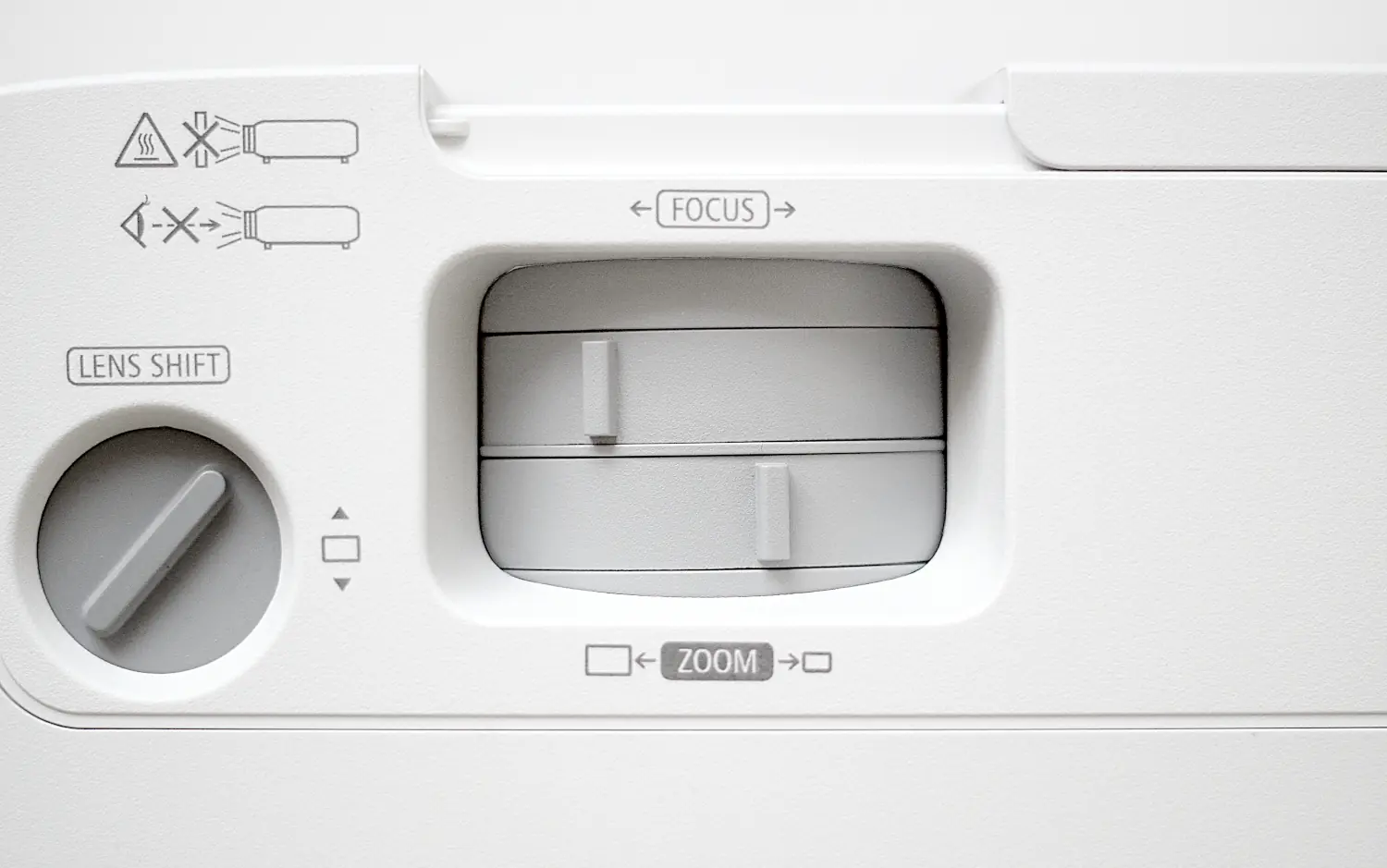
Just as the name suggests, lens shift means that the lens will shift up/down (vertical) or left/right (horizontal) or both or none in order to help us create the perfect image on our projector screen or on a wall or on a white sheet or on whatever surface we project the image on. I totally recommend using a projector screen.
The lens shifts so that we can center our image up to a certain degree. The degree for both the vertical and the horizontal depends on what the projector allows.
For example, we can have +/- 60% V and +/- 24% H. The degrees will depend.
The advantage of having both H & V lens shift is that we don’t have to center our projector perfectly. It allows us to get the perfect image for our line of sight without having to tilt or move left or right until we get the perfect image with the perfect resolution.
Unlike keystone correction, lens shift doesn’t distort image quality and doesn’t impact brightness so the native resolution and top image quality is preserved without any changes.
That’s why, keystone correction should be our last resort.
Frankly, for a projector, lens shift is a crucial feature because decoding shift and offset specs can be time consuming. And it’s not going to be something that beginners will handle with ease. It can be frustrating.
We’re here looking for the best projectors with horizontal lens shift because having control of aligning our image allows us to easily install our projector without too much effort or frustration and you won’t realize how crucial that is until you own such a device.
Best projectors with horizontal lens shift FAQs
Let’s answer some interesting questions about the best projectors with horizontal lens shift.
1. Does horizontal lens shift affect picture quality?
The main difference between lens shift and keystone correction is that lens shift has no loss in the quality of the image. Both are image adjustment options but lens shift is superior because it’s so easy to use to align our image on our screen perfectly and the quality of the image is not affected in any way. Keystone correction is an alteration of the image itself for the correction and that’s why it’s not preferred.
2. Do all projectors have horizontal keystone?
Not all projectors have horizontal keystone. You’ll come across more devices with vertical keystone but there are devices, like the Epson Home Cinema 880, that include both horizontal and vertical keystone correction. However, there are fewer devices that also include lens shift. That is included among more expensive projectors, while the Epson Home Cinema 880 is regarded as a highly affordable one.
3. What projectors have horizontal lens shift?
The simple answer would be that expensive projectors have horizontal lens shift. There’s a complete difference between horizontal lens shift and keystone correction. While cheap and affordable projector under $1,000 won’t have any lens shift only keystone correction, projectors with horizontal lens shift will have prices around $1,500-$5,000 and more. One of the most affordable we could buy is the Epson Home Cinema 3200 and it’s definitely one of the best projectors with horizontal lens shift together with the much more expensive Epson Home Cinema 5050UB, which is absolutely fantastic, and LG CineBeam HU710PW.

